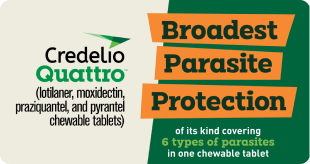
Does your dog have shiny, white teeth - with the exception of pale yellow deposits at the gumline? A little tartar might not seem like a big deal, but it’s actually a warning sign that your dog is in need of dental care. In recognition of National Pet Dental Health Month, learn why tartar is what veterinarians often call “the tip of the iceberg,” and what you can do to keep your dog’s smile clean and healthy.
What Exactly Is Tartar in Dogs?
Tartar, also known as dental calculus, begins with the formation of plaque. Plaque is a translucent film that constantly forms on teeth made up of live active bacteria, saliva, and food particles. It also contains minerals calcium and phosphate, which are present in saliva to help protect the teeth’s enamel.
Within as little as 24 hours, plaque begins to form a hardened, calcified deposit at the gumline. Over time, layers and layers of hardened plaque snowballs to form visible tartar. Tartar is pale yellow to brownish color with a rough surface.
How Does Tartar Affect Your Dog’s Dental Health?
Yellowish tartar is more than just a cosmetic issue. These hardened deposits have a rough, porous surface and create a nook above the gumline where bacteria can cling. Bacteria produces acidic waste products that damage the delicate gum tissue.
With advanced tartar, the gums can actually start to pull away from the base of the tooth, leaving the root exposed. Bacteria can make its way into the pocket between the tooth and the gums, leading to infection that can affect the ligaments that hold the tooth in place. Over time, the dog can experience severe gingivitis, a gum abscess, and/or tooth loss.
Is It Possible To Remove Your Dog’s Tartar At Home?
While small amounts of tartar may begin to soften and chip away with the use of dental treats, chews, and regular brushing, it’s not possible to remove it without a professional cleaning.
It’s crucial to have your dog’s teeth professionally cleaned by a veterinarian to remove tartar and start them off with a clean slate. Then, you can schedule yearly or semi-yearly appointments, using dog toothpaste, dental chews, and a dental water additive to keep plaque at bay.
Is A Professional Dental Cleaning Really Worth It?
Often, tartar above the gumline is just the tip of the iceberg. Your veterinarian will need to use dental x-rays to determine if there is any damage to the gums, root, or jaw below the gumline. During a dental cleaning under anesthesia, your veterinarian will also be able to look for other signs of oral health issues like oral tumors, cracked, missing, and chipped teeth, and abscesses.
During a dental cleaning, your veterinarian will use precise dental instruments to scale away tartar from the inside, outside, and top surface of each tooth. Then, they will polish the surfaces of the teeth to buff away any scratches, creating a smooth surface that makes it harder for plaque to adhere to the enamel, helping to prevent tartar from coming back.
VISION
Every pet deserves to live a long, happy, healthy life.














































